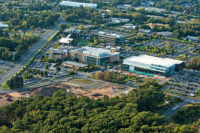The 83-person company also lives large when it comes to incorporating sustainable technologies in its designs. PBA, with four offices throughout the country including locations in Las Vegas and Phoenix, puts a collaborative approach and cost-effective energy efficiency at the forefront of its designs.
“We work closely with architects, consultants and building owners during early phases of the project to improve the synergy between the building envelope and the MEP systems,” PBA Vice President Jim Paul, P.E., LEED AP, says. “Through close collaboration, MEP system capacities and long-term energy use can be reduced and the indoor environment optimized.”
Started on a small scale in 1990 as a mechanical engineering firm, the now employee-owned company has blossomed into a full-service MEP firm specializing in the health care; laboratories; K-12 and higher education, including housing; sports/entertainment and cultural; public; industrial/research and development; power and energy; and office and data center markets. PBA provides MEP design and commissioning services during design and construction phases and during the building’s operation.
To date, PBA, which has active staff memberships in U.S. Green Building Council, ASHRAE and Association of Energy Engineers, has designed seven LEED Silver, six LEED Gold, one LEED Platinum and two LEED-certified buildings. The firm currently is pursuing 10 LEED project certifications (seven Silver, two Platinum, one Gold). PBA has received nearly 20 ASHRAE awards at the chapter, regional, international and national levels.
“Energy conservation has been a key part of the practice as long as we have been in business,” Paul states. “Our desire is to have optimal energy efficiency in the buildings and campuses we design. We focus on cost-effective solutions that pay returns over the life of the facility.”
Worldwide reach
In addition to its work throughout the United States, PBA has taken its sustainable design expertise to the other side of the world. The firm recently was the design engineer on two significant health-care projects in the Middle East.
“Both projects came about because local clients (architectural partners) got the call to go work in the Middle East,” explains Paul, who has been with PBA for more than 20 years. “We’re finding more and more in that part of the world hospitals are being built more like American models and these facilities are hiring Americans to design to American standards. They are looking for a little higher quality in a health-care facility. Working with the local architect/engineer helps to localize the U.S. designs and adjusts our details and specifications to local building practices.”
PBA did work on a six-story health-care facility in Riyadh, Saudi Arabia, and the 12-story King Hussein Jordan Cancer Center in Amman, Jordan. Paul notes a major consideration on the King Hussein facility was the country’s continued struggles with water.
“Jordan is one of the poorest countries in the world when it comes to water,” he says. “It’s a huge issue for them. Water conservation is very big. You have to do everything you can to conserve water. But in the end, you design systems that are simple, efficient and reliable. If the systems are too complicated to maintain the owner won’t be happy with them.”
Collaboration with local engineers and the construction manager on the King Hussein project was critical in terms of specifying workable systems and adhering to budget limits, Paul adds. “We had to design to a budget,” he says. “Early collaboration between the U.S. design team, the owner, the overseas design team and the construction manager was essential in selecting systems that would fit in with the project budget and satisfy the owner’s requirements.”
Meeting with local engineers also provided key guidance for PBA. “We wanted to learn about local practices,” Paul says. “Some systems we are accustomed to using here are not that common over there. If you give them a system that is not common or familiar to them, it’s not going to succeed.”
PBA specified a combination of variable-air-volume reheat and four-pipe fan-coil systems in both projects. “Both systems are simple and reliable,” Paul says. “Fan-coil systems are most commonly used over there, but VAV reheat is needed for certain areas to meet the U.S. health-care codes. We are finding good opportunities with heat recovery chillers since the climate there is predominantly for cooling. Hospitals require a significant amount of heating energy, so we’re finding a lot of opportunity in recovering heat from chillers and using it to provide reheat and to preheat domestic hot water.”
Low-flow fixtures and water reuse systems came into play on the Saudi Arabia design, mainly due to high water costs in that country. “Our first approach is ultra-low-flow fixtures,” Paul says. “If the project budget can afford it and water rates are high enough, we’ve designed graywater systems that reuse water from sinks and lavs. We clean and filter that water and use it for flushing toilets. We inject a dye into the graywater system and the piping is totally separate so there is no chance that graywater gets into the potable water system. When the water cost is high enough like it is in Saudi Arabia, a graywater system pays for itself.”
LEED the way
Closer to home, PBA put its sustainable expertise to work on a pair of LEED-certified Michigan-based projects. The Ann Arbor Municipal Center put on a 110,000-sq.-ft. building addition (that includes the 15th District courthouse, a police station and a jail) and also renovated the existing Larcom Building. PBA specified a 12-panel solar thermal system for the Larcom Building.
“The 12 panels mainly supplement the water heaters,” says PBA Project Leader Phil DeSantes, who started with the firm in 1997 while still in high school (co-op program). “Rather than heat the water all the way from 40° to 140° F, they are heating the water at the heated temperatures from the panels. The water heaters do not have to work as hard. They are saving energy and lowering utility costs.”
The building addition to the municipal center packs a more powerful solar punch with 28 panels, 12 serving the domestic water system and 16 serving the hot water heating system. The design was kept similar to the Larcom array for ease of installation. “We worked with a solar consultant to give us ideas on best angles and best positioning and how to get the optimal square footage so they could get maximum use of the panels,” DeSantes says. “Some of the appeal of solar is being able to display panels so the public can see them as well.”
Both systems feature a solar heat dump option. “This option provides a means of protecting the system from overheating, but the excess heat can be used wherever the client has a need,” DeSantes says.
The solar systems contain Solar Skies SS-40 panels, Bell & Gossett double-wall brazed-plate heat exchangers and circulating pumps, Wessels expansion tanks, Laars storage tanks and Bradford White water heaters.
“Depending on the weather, they are only heating water 50° to 70°,” DeSantes says. “That’s a huge savings from an energy standpoint.”
Low-flow fixtures in the municipal center include Zurn pint flush urinals and flush valves, Zurn dual-flush valves for water closets, Zurn lavs and faucets, Zurn sink faucets and Kohler fixtures. A rainwater harvesting system provides all irrigation water for the property.
DeSantes was front-and-center on another sustainable project at the Oakland County International Airport in Waterford Township, Mich. A smaller-scale solar system features photovoltaic panels for electrical purposes, and a single solar thermal panel on the roof supplements domestic water heating.
The airport project uses the solar panel and a drainback tank from Solar Skies, Bell & Gossett pumps and therma-flow balancers, Wessels expansion tanks and a Laars storage tank with integral heat exchanger. The solar system at the airport is mated to a 120-gal. Lochinvar electric water heater. The use of a heat exchanger integral to the solar storage tank helps create a smaller footprint for the solar system.
“There is not a ton of water-heating demand at the airport, but they are seeing some savings with that system,” DeSantes says.
Other green features include a living wall that uses rainwater for plant vegetation, wind turbines and the widespread use of low-flow bathroom fixtures. The living wall taps off a portion of the rain conductor system and uses that water to mist the plants growing on the wall. The airport contains Delta lav faucets and low-flow showerheads, Zurn sink faucets, Sloan faucets, Zurn urinals and water closets and Sloan solar-powered flush valves.
DeSantes enjoys the challenge of incorporating sustainable designs like he did in the municipal center and airport into the projects he works on. “More than anything, it gives you the opportunity to do something different and look into a project a little deeper to see what optimal savings you can achieve,” he says. “You put your thinking cap on and see where you can make room for these added sustainable design features.”
BIM no longer a buzzword
PBA is a strong advocate for using building information modeling in its MEP designs and consistently utilizes the most current Autodesk Revit MEP software on the market.
“Contractors utilize the BIM MEP and lighting system designs we provide, knowing it is highly effective in enhancing the overall coordination process throughout the life of the project,” PBA Vice President George Isherwood, P.E., says. “This has become a very powerful tool in building design, and it will continue to grow in popularity as more firms recognize its capability.”
DeSantes adds: “Revit is an intelligent piece of software. You can add in a solar panel in the design program and then assign its flow, and when everything is tied together you see the total flow and can tie it into other equipment features.”
Paul likes the fact BIM software helps in better connecting with other project principals. “It makes it easy to illustrate to owners and architects what’s going on as opposed to using a 2D drawing,” he says. “We can illustrate a point easier for spatial coordination. BIM helps us improve designs and buildings are getting constructed quicker with fewer change orders. That makes everybody happy.”
Paul sees BIM software being an even greater tool for engineers going forward, especially when it comes to system calculations.
“Every request for proposal we get now is asking us to use BIM in some form,” he says. “The question is why and what do you want to use it for? It’s practically a given we’ll use it on almost every project. The degree to which we adopt new technology and software is up to us. In the future I can see things such as fan and pump calculations being automated and being able to see the effect of a design change on energy use almost instantly instead of having to go through a day or two of calculations. There is some software out there right now like that and we’ve tried some load-calculation software programs tied to BIM. New technology will improve productivity in the long run.”
Paul, Isherwood and DeSantes agree green building designs and technologies are here to stay. Paul points to ASHRAE coming out with a rating system for buildings similar to that of a miles-per-gallon sticker on a car.
“I see energy efficiency being more and more important in the future,” Paul says. “The American Institute of Architects has the 2030 Challenge that by 2030 all new buildings will be net zero buildings. I see major architecture and engineering firms not waiting until 2030 and seeing how much better buildings can be compared to the energy codes by 2015 and 2025. Architects and engineers are taking energy usage in buildings much more seriously. It’s becoming a much bigger part in what is considered normal. The construction industry is realizing the impact we have on energy use. People are seeing the need to change. Owners are demanding buildings be more energy efficient and we have to find systems to do that.”
DeSantes adds, “The possibilities for green design are endless.”








